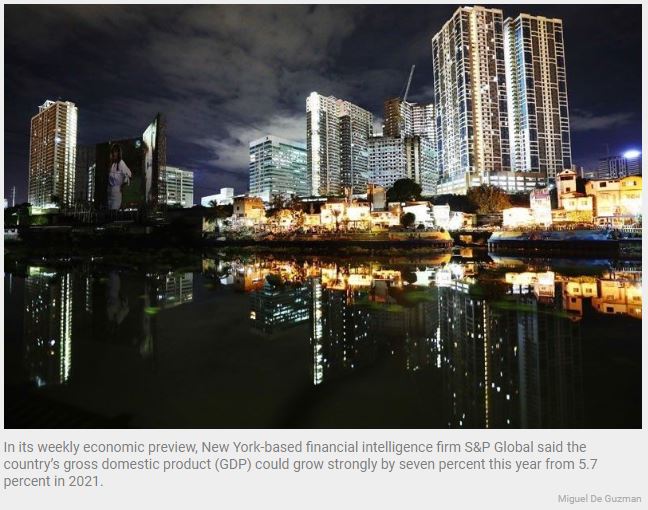Philippines: Economic recovery momentum at risk from elevated inflation
MANILA, Philippines — The Philippine economy is expected to continue its recovery this year, with growth expected at seven percent, but external headwinds from elevated inflation could put a halt on this momentum.
In its weekly economic preview, New York-based financial intelligence firm S&P Global said the country’s gross domestic product (GDP) could grow strongly by seven percent this year from 5.7 percent in 2021.
This, however, is slightly lower than the 7.2 percent projection S&P made in January.
The GDP expectation also settles at the lower end of the revised seven to eight percent target of the government.
Rajiv Biswas, S&P Global Market Intelligence chief economist for Asia-Pacific, noted that the strong GDP growth would be driven by strengthening private consumption spending, an upturn in government infrastructure spending and improving remittance inflows.
“However, the Philippines is facing external headwinds from rising world inflation, notably from higher world oil prices, as well as moderating global economic growth,” Biswas said.
“As the US Fed and ECB (European Central Bank) tighten monetary policy due to rising inflation pressures, this is expected to result in weakening growth momentum in the US and EU, which will also act as a drag on growth for the Philippines’ export sector,” he said.
Nonetheless, the Philippines could still bank on the domestic front as the easing of pandemic-related travel restrictions has prompted the reopening of the tourism sector.
If sustained during the second half of 2022 and into 2023, Biswas said this would provide an important boost to the economy.
Prior to COVID, tourism accounted for 12.7 percent of the country’s GDP. As of last year, its share is barely even half of its pre-pandemic level at 5.1 percent.
Tourism in the country largely remains dominated by domestic tourism and Biswas said the recovery of this sector could be a significant growth driver by the second semester.
Meanwhile, S&P emphasized that the Philippines is on track to become one of the region’s $1-trillion economies, joiningChina, Japan, India, South Korea, Australia, Taiwan and Indonesia.
This will be buoyed by the rapid growth in private consumption spending and strong growth in urban household incomes.
Such a strong growth in the size of the economy is seen driving per capita GDP to $6,500 by 2030 from the current level of $3,300.
Biswas said this will help to underpin the growth of the Philippine domestic consumer market, catalyzing foreign and domestic investment into many sectors in the country.
Source: https://www.philstar.com/business/2022/06/27/2191093/economic-recovery-momentum-risk-elevated-inflation


 Thailand
Thailand




